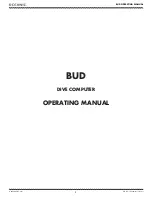
(714) 891-0008 • www.kinginstrumentco.com
When it comes to flow...we’re instrumental.
1
7710 Series
Installation Instructions
FLOW METER LIMITED WARRANTY
Meters are warranted against defects in materials and workmanship to the original user for a period of
thirteen (13) months from the date of factory shipment, provided the meter is installed, operated and main-
tained in accordance with King Instrument Company’s instructions and recommendations.
This warranty does not apply if failure is caused or contributed to by any of the following: improper han-
dling, improper storage, abuse, unsuitable application of the product, lack of reasonable and necessary
maintenance, use exceeding suggested pressure and temperature maximums, improper packaging for
return, or repairs made or attempted to be made by anyone other than King Instrument Company, Inc.
KING INSTRUMENT COMPANY, INC. MAKES NO WARRANTY AS TO THE FITNESS OF ITS PRODUCTS FOR SPE-
CIFIC APPLICATIONS.
This warranty is valid for the original end-user only and does not apply to products that have been damaged
or modified. This warranty is non-transferrable and is limited to replacement or repair. The liability of King
Instrument Company arising out of its supply of the products, or their use, shall not in any case exceed the
cost of correcting defects in the products as set forth above.
THIS WARRANTY IS A LIMITED WARRANTY AND SHALL BE IN LIEU OF ANY OTHER WARRANTIES, EXPRESSED
OR IMPLIED, INCLUDING BUT NOT LIMITED TO ANY IMPLIED WARRANTY OR MERCHANTABILITY OR FITNESS
FOR A PARTICULAR PURPOSE. THERE ARE NO OTHER WARRANTIES WHICH EXIST BEYOND THE DESCRIPTION
OR FACE HEREOF.
IN NO EVENT SHALL KING INSTRUMENT COMPANY BE LIABLE FOR LOSS OF PROFITS, INDIRECT, CONSEQUEN-
TIAL OR INCIDENTAL DAMAGES.
Products should be returned, prepaid, to King Instrument Company, Inc. with proof of purchase. Call factory
for Return Merchandise Authorization (RMA) number and return instructions.
THIS IS IMPORTANT INFORMATION.
READ IT CAREFULLY BEFORE BEGINNING WORK.
1) Inspect meter for damage that may have occurred during shipping.
Report any damage to the container to the freight carrier immediately.
2) Remove any shipping material placed in the inlet and outlet of the
meter. (This is done to prevent damage caused by movement of the
float during shipping).
3) Make sure your pressure, temperature, fluid and other requirements
are compatible with the meter and components (including o-rings).
4) Select a suitable location for installation to prevent excess stress on
the meter which may result from:
a) Misaligned pipe.
b) The weight of related plumbing.
c) “Water Hammer” which is most likely to occur when flow is
suddenly stopped as with quick closing solenoid operated
valves. (If necessary, a surge chamber should be installed. This
will also be useful in pressure start-up situations.)
d) Thermal expansion of liquid in a stagnated or valve isolated
system.
e) Instantaneous pressurization which will stress the meter and
could result in tube failure.
NOTE: In closed thermal transfer or cooling systems, install the
meter in the cool side of the line to minimize meter expansion and
contraction and possible fluid leaks at the threaded connections.
5) Handle the meter carefully during installation.
a) Use an appropriate amount of teflon tape on external pipe
threads before making connections. Do not use paste or stick
type thread sealing products.
6) Install the meter vertically with the inlet port at the bottom.
No piping runs are required. Because the guide rod extends
from the top of the meter during operation, 4” of straight pipe
must be provided at the outlet of the meter.
7) Meters with stainless steel fittings will support several feet
of pipe as long as significant vibration or stress resulting from
misaligned pipe are not factors
8) Meters used in gas service should have suitable valves plumbed in
at the inlet and outlet of the meter. These valves should be no more
than 1-1/2 pipe diameters from the meter ports. The valve at the
outlet should be used to create back pressure as required to prevent
float bounce. It should be set initially and then left alone. The inlet
valve should be used for throttling purposes. Depending on the
installation, valves may not be essential, but they are most useful in
many installations. Remember: To get a correct reading of flow in gas
service, it is necessary to know the pressure right at the outlet of the
meter (before the valve).
ADDITIONALLY:
• 7710 Series meters are designed for vertical installation only. (Inlet at
bottom, Outlet at top)
• Do not remove or adjust the screws on the back of the indicator
housing. These screws were positioned during factory calibration and
represent the zero adjustment. If the pointer is set on zero, proceed























